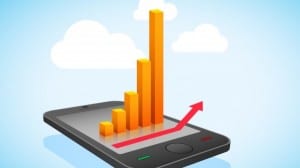 In part three of our four-part series discussing app promotion and optimization, I wanted to share some tips for app store optimization. Or, said another way: How can you be sure users will be able to find your app in the store?
In part three of our four-part series discussing app promotion and optimization, I wanted to share some tips for app store optimization. Or, said another way: How can you be sure users will be able to find your app in the store?
Sixty-three percent of apps are discovered through app store searches, with others discovered via general browsing and the Recommended for You or Top 20 Apps section. What can you do to be found using these discovery methods? Well, each one runs a bit differently, and I’ve outlined the best practices for the iTunes and Google Play stores …
Google Play – App Store Search Optimization (AS0)
1. Effectively tackle your app store landing page:
- Start by using ASO tools to conduct your keyword research. Try Google Keyword Planner, AppCod.es, Search Man, MobileDevHQ or Sensor Tower.
- Optimize your App name – it should include your target keyword within the maximum character limit of 30.
- Create a killer app description.
–This description is what sells your app. Within the 4,000-character limit, you should use your target keyword at least five times.
–You can include a short snippet from review sites, provide reasons to download, highlight the number of users, reference other apps you’ve created and include quotes from users with links to social media platforms – embedded tweets, etc. - Create a standout app icon.
–It should be simple, it should not use words, and it should appear unique amongst its counterparts in the stores. - Highlight app screenshots of the best features.
- Select the app type (either “applications” or “games”).
- Add a YouTube demo video to your app store page. Using video on your landing page has been shown to improve conversion rates by as much as 80 percent.
- Localize your app and marketing materials. You can also upload localized hi-res icons, screenshots, feature graphics, promo graphics and promo video URLs for each language version of your app.
- Link to the app landing page on your website.
2. Understand and influence other app store ranking factors:
There are a variety of other factors that influence your findability in the app store (some of which have been highlighted by Google themselves). These include:
- Using a Google+ plugin, as the more pluses your app gets, the more visible it is in the app store
- Getting a large number of searches of your app by name – Google recommends asking your audience to “Search for us on the Google Play store” when promoting
- The total number of downloads and “long installs” (negated by uninstalls)
- The install rate (number of installs per hour and over last 30 days)
- Your app’s aggregate rating and number of ratings
- The number of reviews
- Being able to use all features of your app across different devices
- Prompt app support and bug-fixing
- The time since your last update (regular updates to features and bugs are critical)
- Speed in which your app downloads and runs
- Daily usage of the app by users
- Which apps a customer’s peer group has voted for on Google+
- Online reviews outside of the app’s environment
- Frequency with which your app is used (reported by some developers)
- Using Google’s deep linking so that the content on your app can be visible in Google search results – You make your apps compatible by 1) updating their apps to support deep linking; and 2) submitting an app deep-link sitemap to Google Webmaster tools. (Note, Bing also has similar functionality)
- Google Play optimizing for the Recommended for You section; Google Play I/O webinar has a variety of other tactics
iTunes – App Store Search Optimization (ASO)
1. Tackle your iOS App Store landing page:
Many of these steps are very similar to the Google Play store, except that Apple has a few unique fields, Iike the keyword field).
- Start by using ASO tools to conduct your keyword research. Like Google Keyword Planner, AppCod.es , Search Man, MobileDevHQ or Sensor Tower.
- Optimize your app name (you have 255 characters, but the user only sees 19 characters on their iPhone).
- Create a killer app description.
–You have a 4,000-character limit to sell your app.
–It should be optimized based on your keyword research.
–Include a brief opening paragraph or two and a short bulleted list of main features.
–Localize for markets where appropriate.
–Include user reviews, accolades and testimonials at the end, if at all. - Keywords field.
–(iOS only) There is a 100-character limit in the field for you to list your keywords.
–Don’t repeat keywords that are already in your title.
–Separate keywords by commas, but don’t use spaces. - Create a stand-out app Icon.
–It should be simple, it should not use words, and it should stand out from others in the store. - Add app screenshots of the best features.
- Localize your app and marketing materials.
- Link to the app landing page on your website.
iTunes – App Store Browse Optimization
While in Google Play the majority of app discovery is via search, in the iOS store it’s through the browse rankings (especially Top 10 and Top 25) and New & Noteworthy lists, which are available from the App Store.
How do you get on these lists?
According to U.S. market data collected by the Loadown in 2013, iOS app publishers and developers making version updates and price changes improve their positioning on iTunes’ Top Paid, Top Free and Top Grossing lists. David Renard, CEO of the Loadown, stated the reason: “When a paid or free app is updated to a new version, the developer can change the name, icon, description, screenshots and keywords of the app as well as force users to notice the new update.” For price changes, he adds, “Sales get featured on an Apple RSS feed that is distributed to thousands of sites and Twitter feeds focused on promoting apps that have gone on sale or have recently become free.”
2. Understand and influence app store ranking factors:
The additional factors in the iOS App Store algorithm include:
- Total Installs
- Length of installs
- Number of reviews
- Aggregate rating
- Time since initial launch
- Time since last update
- Install rate (installs per 24 hours)
- App downloaded but not installed
- Optimizing for Top Free Apps (must have 72,000+ downloads per day)
The iOs developer library outlines many of these best practices.
In part four of our series we’ll be looking at strategies pertaining to getting your potential consumer base to install your app.
Click HERE to view PART 1 of the series.
Click HERE to view PART 2 of the series.


